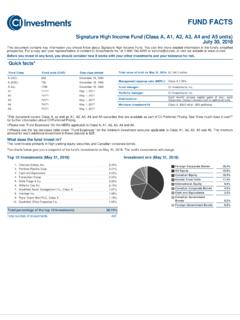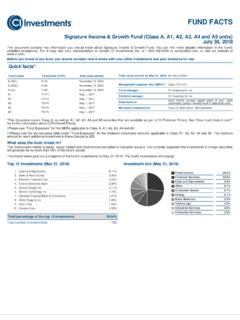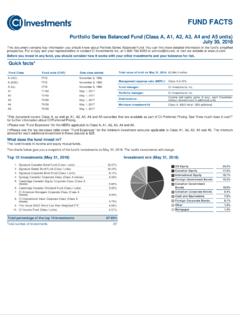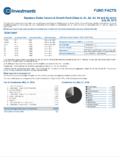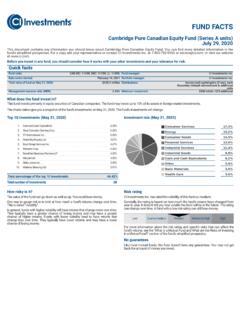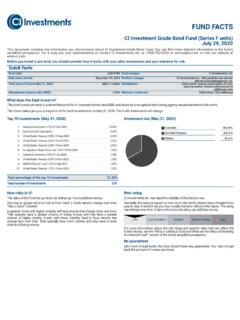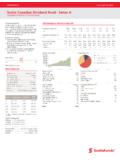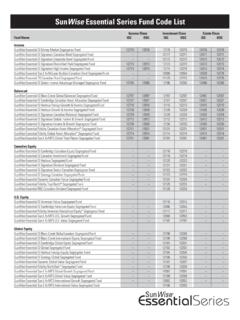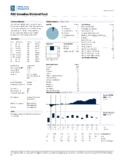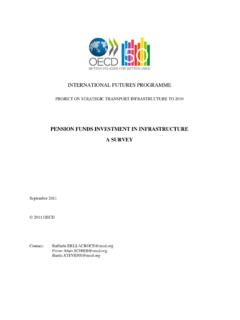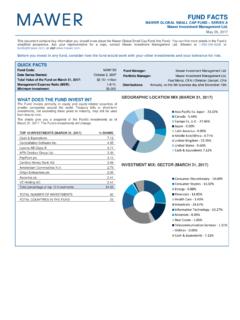Transcription of FUND FACTS - CI Investments
1 fund 10 Investments (June 28, 2019)1. Cambridge Bond fund (Class A units)2. Cambridge canadian Short-Term Bond Pool (Class Iunits)3. Cambridge canadian Long-Term Bond Pool (Class Iunits)4. Keyera Franco-Nevada Emera Cash and Cash Equivalents8. CSX Athene Holding McKesson percentage of the top 10 investmentsTotal number of investmentsInvestment mix (June 28, 2019)How risky is it?The value of the fund can go down as well as up. You could lose way to gauge risk is to look at how much a fund s returns change overtime.
2 This is called volatility .In general, funds with higher volatility will have returns that change more overtime. They typically have a greater chance of losing money and may have agreater chance of higher returns. Funds with lower volatility tend to havereturns that change less over time. They typically have lower returns andmay have a lower chance of losing ratingCI Investments Inc. has rated the volatility of this fund as low to , the rating is based on how much the fund s returns have changedfrom year to year.
3 It doesn t tell you how volatile the fund will be in the rating can change over time. A fund with a low risk rating can still more information about the risk rating and specific risks that can affectthe fund s returns, see the "What is a Mutual fund and What are the Risks ofInvesting in a Mutual fund ?" section of the fund s simplified guaranteesLike most mutual funds, this fund doesn t have any guarantees. You may notget back the amount of money you Asset Allocation Corporate Class (Class A shares)August 2, 2019 This document contains key information you should know about Cambridge Asset Allocation Corporate Class.
4 You can find more detailed information in thefund's simplified prospectus. For a copy ask your representative or contact CI Investments Inc. at 1-800-792-9355 or or visit our website you invest in any fund , you should consider how it works with your other Investments and your tolerance for factsFund code: CAD ISC: 2322; DSC: 3322; LL: 1522; USD ISC: 2517; DSC: 3517; LL: 1217; fund manager:CI Investments class started:December 31, 2007 Portfolio manager:CI Investments Inc. with portfolio sub-adviser CI Global Investments value of fund on June 28, 2019:$3, millionDistributions:Ordinary dividends (if any) and capitalgains dividends (if any), each March,June, September and December, Defaultreinvestment in additional sharesManagement expense ratio (MER) investment:$500 initial / $25 additionalWhat does the fund invest in?
5 This fund invests in a combination of primarily canadian equity and fixed income securities. Up to 49% of the fund 's assets may be invested in other types ofsecurities and foreign charts below give you a snapshot of the fund 's Investments on June 28, 2019. The fund 's Investments will and to mediumMediumMedium to highHighCambridge Asset Allocation Corporate Class (Class A shares)Who is this fund for?This fund may be suitable for you if you:want to invest in a diversified portfolio of equity and fixed incomesecuritieswant active asset allocation among equity securities, fixed incomesecurities and cashare investing for the medium termcan tolerate low to medium riskA word about taxIn general, you'll have to pay income tax on any money you make on a much you pay depends on the tax laws of where you live and whetheryou hold the fund in a registered plan.
6 Such as a Registered RetirementSavings Plan or a Tax-Free Savings in mind that if you hold your fund in a non-registered account, funddistributions are included in your taxable income, whether you get them incash or have them has the fund performed?This section tells you how Class A securities of the fund have performed over the past 10 calendar years. Returns are after expenses have been expenses reduce the fund 's returnsThis chart shows how Class A securities of the fund performed in each of the past 10 calendar years.
7 This fund class dropped in value in 2 of the last 10calendar years. The range of returns and change from year to year can help you assess how risky the fund has been in the past. It does not tell you how thefund will perform in the and worst 3-month returnsThis table shows the best and worst returns for Class A securities of the fund in a 3- month period over the past 10 calendar years. The best and worst 3-month returns could be higher or lower in the future. Consider how much of a loss you could afford to take in a short period of months endingIf you invested $1,000 at the beginning of the periodBest 31, 2009 Your investment would be $1, 30, 2008 Your investment would be $ returnThe annual compounded return of Class A securities of the fund was over the past 10 years.
8 If you had invested $1,000 in the fund 10 years ago, yourinvestment would now be worth $1,615.(%) Asset Allocation Corporate Class (Class A shares)How much does it cost?The following tables show the fees and expenses you could pay to buy, own and sell Class A securities of the fund . The fees and expenses including anycommissions can vary among classes of a fund and among funds. Higher commissions can influence representatives to recommend one investment overanother. Ask about other funds and Investments that may be suitable for you at a lower Sales chargesYou may have to choose a sales charge option when you buy Class A securities of the fund .
9 Ask about pros and cons of each you payHow it worksin percent (%)in dollars ($)Initial sales charge0 to of the amount youbuy$0 to $ on every$1,000 you payYou and your representative decide on the initial sales charge is deducted from the amount you buy. It goes to your representative's firm as a deferred sales chargesIf you sell within:1 year of buying2 years of buying3 years of buying4 years of buying5 years of buying6 years of buying7 years of buyingAfter 7 years$0 to $ on every$1,000 of original costyou sellThe standard deferred sales charge is a set rate and is deducted from the amount you sell based on the initial cost andnumber of those you buy the fund , we pay your representative's firm a commission of 5%.
10 Any standard deferred sales chargeyou pay when you sell the fund goes to can sell up to 10% of your securities each year without paying a standard deferred sales charge subject to certainrestrictions ("10% free redemption right"). Your 10% free redemption right is reduced by the equivalent number ofsecurities you would have received if you had reinvested any cash distributions you received during the calendar you exercised your 10% redemption right and redeem your securities before the standard deferred sales chargeschedule has expired, your standard deferred sales charge on a full redemption would be the same as if you had notredeemed securities under your 10% free redemption you hold the fund in a non-registered account.
